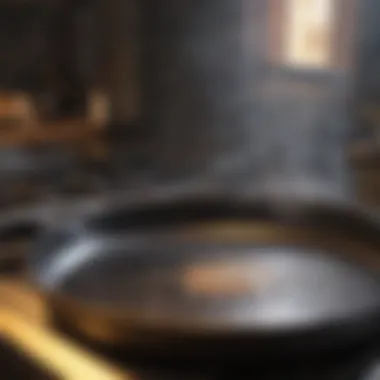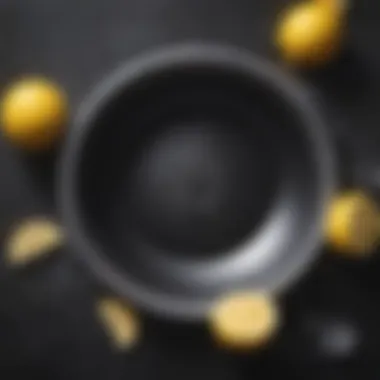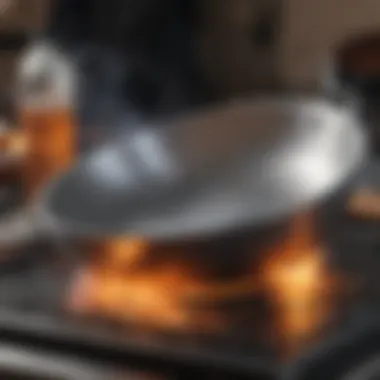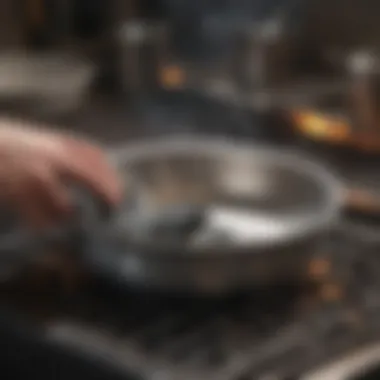Expert Guide: How to Clean a Burnt Aluminum Pan Safely and Effectively


Interior Design Tips
When it comes to cleaning a burnt aluminum pan, it's essential to have the right techniques at your disposal. Whether you're dealing with light scorch marks or a severely burnt pan, the journey to restoring its shine begins with a few key steps. First, gather your supplies, including white vinegar, baking soda, a scouring pad, and a gentle dish soap. These natural ingredients will play a crucial role in restoring your pan without causing damage.
Starting the cleaning process, fill the burnt pan with water and add a generous amount of white vinegar. Allow the mixture to simmer on low heat for about 10-15 minutes, softening the burnt residue and making it easier to scrub off. Discarding the vinegar solution, sprinkle baking soda over the remaining residue, creating a paste with a little water. Gently scrub the paste with a scouring pad, focusing on areas with stubborn stains.
Next, rinse the pan thoroughly with water and dish soap to remove any remaining residue. For tougher stains, consider using a mixture of water and baking soda to create a gentle abrasive solution. Continue scrubbing in circular motions until the burnt marks start to lift. Remember to avoid harsh chemicals or metal scrubbers that could damage the aluminum surface.
After cleaning the pan, dry it thoroughly with a soft cloth to prevent water spots or tarnishing. If there are lingering odors, you can also rub the pan with a lemon half to deodorize it naturally. By following these steps and utilizing simple yet effective cleaning techniques, you can reclaim the beauty of your burnt aluminum pan with ease. Stay tuned for more expert tips on maintaining and restoring your kitchen essentials.
Understanding the Problem
When dealing with a burnt aluminum pan, understanding the underlying causes and effects is crucial. Burnt residue in pans can result from various factors, such as high heat exposure, food residue accumulation, and improper cleaning methods. High heat exposure is a common issue that can lead to food getting stuck and burnt onto the pan surface, affecting not only the taste of the food but also the overall cooking performance. Food residue accumulation is another significant factor, wherein leftover food particles build up over time, causing stains and affecting the pan's appearance. Additionally, improper cleaning methods can worsen the burnt stains, making them harder to remove and impacting the pan's longevity. By grasping these causes, you can approach the cleaning process more effectively, ensuring a successful outcome without causing further damage to the pan.
Causes of Burnt Residue
High Heat Exposure
High heat exposure plays a crucial role in creating burnt residue on aluminum pans. When pans are subjected to excessive heat, food can easily burn and stick to the surface, leading to stubborn stains that are challenging to remove. The intense heat causes food particles to carbonize, resulting in a layer of burnt residue that affects both the pan's aesthetics and functionality. While high heat is essential for certain cooking techniques, it can also be detrimental when not controlled properly, emphasizing the need for vigilant heat management during cooking.
Food Residue Accumulation
The accumulation of food residue is another common cause of burnt stains on aluminum pans. Over time, as you use the pan for cooking, small food particles can get trapped and build upon its surface. These residues gradually turn into burnt stains, posing a cleanliness issue and affecting the overall look of the pan. Food residue accumulation not only impacts the pan's visual appeal but can also lead to a lingering food taste, compromising the flavors of your dishes. Therefore, regular cleaning and maintenance practices are essential to prevent the buildup of food residues.
Improper Cleaning Methods
Using improper cleaning methods can exacerbate burnt residue problems on aluminum pans. Harsh cleaners or abrasive scrubbing pads can damage the pan's surface, making it more susceptible to staining and reducing its lifespan. Inadequate cleaning techniques may fail to address burnt stains effectively, leaving behind unsightly marks that persist even after cleaning attempts. It is crucial to follow recommended cleaning guidelines and choose appropriate cleaning products to preserve the pan's integrity and ensure a thorough cleaning process.
Materials Needed


When it comes to addressing the challenge of cleaning a burnt aluminum pan, having the right materials is crucial. The selection of cleaning agents can significantly impact the outcome of the cleaning process. In this article, we will delve into the importance of the materials required for effectively restoring the shine of your aluminum cookware. Emphasizing natural ingredients and specialized products will not only aid in the removal of burnt residue but also ensure the longevity of your pan.
Natural Ingredients
Baking Soda
Baking soda stands out as a versatile and effective natural cleaner for tackling burnt residue on aluminum pans. Its abrasive yet non-destructive nature allows for gentle scrubbing without causing damage to the pan's surface. The alkali and mild abrasive qualities of baking soda make it an ideal choice for breaking down tough burnt stains. Despite its effectiveness, baking soda is gentle on the aluminum pan, preventing scratches and maintaining the integrity of the cookware. Moreover, its affordability and availability make it a convenient option for those looking to restore their pans without harsh chemicals.
Vinegar
Vinegar, known for its acidic properties, plays a vital role in cleaning burnt aluminum pans. The acid in vinegar helps in loosening burnt food particles, making them easier to remove. Its natural acidity not only aids in the cleaning process but also serves as a disinfectant, removing harmful bacteria or germs that may be lingering on the pan's surface. While vinegar effectively cuts through tough stains, it is essential to rinse the pan thoroughly after use to avoid any lingering odor.
Lemon Juice
Lemon juice offers a refreshing and natural approach to cleaning burnt aluminum pans. The citric acid present in lemon juice works as a powerful degreaser, breaking down burnt food remnants effortlessly. Additionally, the natural fragrance of lemon adds a pleasant aroma during the cleaning process. Lemon juice's gentle yet effective cleansing properties make it a popular choice for those seeking a natural and eco-friendly solution to stubborn burnt stains.
Specialized Cleaning Products
Aluminum Cleaner
An aluminum cleaner is specifically formulated to address burnt residues and stains on aluminum surfaces. Its potent cleaning agents target tough stains without compromising the integrity of the pan. The specialized formula of an aluminum cleaner ensures thorough cleaning while protecting the aluminum surface from damage. Choosing a reputable aluminum cleaner can significantly simplify the cleaning process and restore the pan to its original shine.
Non-Abrasive Scrubbing Pads
Non-abrasive scrubbing pads offer a gentle yet effective approach to removing burnt residue from aluminum pans. These pads are designed to provide sufficient scrubbing power without scratching or damaging the pan's surface. The soft texture of non-abrasive scrubbing pads ensures thorough cleaning without leaving any unsightly marks. Their versatility and ease of use make them an indispensable tool for restoring the pristine condition of your aluminum cookware.
Aluminum Polish
Aluminum polish serves as the final touch in rejuvenating a burnt aluminum pan. This specialized product helps in restoring the luster and shine of the pan's surface after the cleaning process. By eliminating any remaining stains or dullness, aluminum polish enhances the visual appeal of the cookware. Its protective properties create a barrier against future stains, prolonging the pan's cleanliness. Using aluminum polish adds a glossy finish to the pan, making it look as good as new.


Step-by-Step Cleaning Process
In the realm of cleaning burnt aluminum pans, the Step-by-Step Cleaning Process holds paramount significance. This process not only ensures the removal of stubborn burnt residues but also aims to restore the pan's functionality and aesthetics. By following a systematic approach to cleaning, individuals can effectively address the damage caused by burnt stains. Embracing a structured cleaning process allows for a thorough restoration of the pan's original shine and surface texture, promoting longevity and usability.
Preparation
Boiling Water
The utilization of Boiling Water in the cleaning process provides a foundational step towards tackling burnt residues on aluminum pans. Boiling water is a versatile and efficient solvent that aids in loosening burnt-on food particles, making them easier to remove. Its high temperature acts as a catalyst for breaking down tough stains, facilitating a more effective cleaning outcome. Boiling water's accessibility and affordability make it a popular choice for initiating the cleansing process of burnt aluminum pans. While its effectiveness in softening burnt residues is commendable, precautions should be exercised due to the risk of burns associated with handling boiling water.
Ventilation
When delving into the cleaning process of burnt aluminum pans, ensuring proper Ventilation plays a crucial role. Ventilation helps in dispersing potentially harmful fumes that may arise from the cleaning agents or burnt residues. It supports a safer environment by enhancing air circulation, reducing the concentration of airborne particles, and minimizing the risk of respiratory discomfort. The inclusion of adequate ventilation in the cleaning area not only promotes a healthier cleaning environment but also contributes to a more comfortable and productive cleaning experience.
Cleaning Techniques
Baking Soda Scrub
The application of a Baking Soda Scrub introduces a mild abrasive element that aids in gently scrubbing away burnt-on residues from aluminum pans. Baking soda’s natural abrasive properties enable effective stain removal without causing damage to the pan's surface. Its non-toxic nature and versatility make it a preferred choice for environmentally-conscious individuals seeking a gentle yet potent cleaning solution. The Baking Soda Scrub's ability to exfoliate stubborn burnt stains while being gentle on the pan's surface is a notable advantage in the cleaning process.
Vinegar Soak
Introducing a Vinegar Soak in the cleaning regimen of burnt aluminum pans offers a proactive approach to dissolving tough residues. Vinegar's acidic properties work effectively in breaking down burnt food remnants, making them easier to wipe off. The Vinegar Soak's natural degreasing and antibacterial properties further enhance its cleaning capabilities, leaving the pan sanitized and deodorized. While Vinegar Soak proves efficient in tackling burnt stains, it is essential to exercise caution with prolonged exposure to vinegar, particularly on certain pan coatings.
Lemon Juice Treatment
Incorporating a Lemon Juice Treatment in the cleaning process of burnt aluminum pans infuses a refreshing approach to stain removal. Lemon juice's natural acidity acts as a potent solvent for breaking down burnt-on residues, while its pleasant citrus aroma enhances the overall cleaning experience. The Lemon Juice Treatment's ability to not only cleanse the pan but also impart a fresh scent adds a delightful touch to the cleaning process. However, individuals with sensitivities to citrus-based products should exercise care when utilizing this technique.
Specialized Products Application


Aluminum Cleaner Usage
Employing an Aluminum Cleaner in the cleaning process of burnt aluminum pans offers a specialized approach to addressing stubborn stains. Aluminum cleaners are formulated to target tough residues without damaging the pan's surface, providing a thorough and effective cleansing experience. The unique formulation of Aluminum Cleaner ensures optimal stain removal while maintaining the integrity of the pan's material, promoting a long-lasting and vibrant finish. However, it is essential to follow the manufacturer's instructions and safety precautions when utilizing specialized cleaners.
Non-Abrasive Scrubbing
Integrating Non-Abrasive Scrubbing techniques into the cleaning routine of burnt aluminum pans introduces a gentle yet effective method for handling difficult stains. Non-abrasive scrubbing pads are designed to lift residues without scratching or damaging the pan's surface, ensuring a pristine finish after cleaning. The use of non-abrasive scrubbing pads minimizes the risk of abrasions or dullness on the pan, preserving its appearance and functionality. While non-abrasive scrubbing pads offer superior stain removal, it is advisable to test them on a small area of the pan to avoid unintended damage.
Polishing the Pan
Polishing the Pan serves as the final touch in revitalizing the appearance of a burnt aluminum pan after thorough cleaning. Utilizing aluminum polish helps in restoring the pan's shine and luster, giving it a renewed appearance. The polishing process not only enhances the aesthetics of the pan but also forms a protective layer that shields it from future stains and corrosion. Regular polishing not only maintains the pan's visual appeal but also strengthens its durability and resistance to tarnishing. When polishing the pan, care should be taken to follow the recommended application guidelines to achieve optimal results.
Maintenance Tips
Maintenance tips are crucial for the upkeep of your aluminum pan. By following proper maintenance advice, you can extend the lifespan of your cookware and ensure optimal performance. Preventive measures play a vital role in avoiding burnt residues and maintaining the aesthetic appeal of your pan. Proper heat control is essential to prevent overheating, which can lead to burnt food residues. By monitoring and adjusting heat levels while cooking, you can prevent sticky residues from forming on the pan's surface.
Regular cleaning routines are equally important in preserving the quality of your aluminum pan. Establishing a consistent cleaning schedule helps prevent the buildup of burnt stains and food residues. This regular maintenance will not only enhance the pan's longevity but also contribute to better cooking results. By incorporating these preventive measures into your cooking routine, you can ensure that your aluminum pan retains its shine and functionality over time.
Preventive Measures
Proper Heat Control
Proper heat control is a fundamental aspect of maintaining your aluminum pan. By managing heat levels effectively, you can prevent food from burning and sticking to the pan's surface. The key characteristic of proper heat control lies in adjusting the burner to the appropriate temperature for the cooking task at hand. This method is popular among home cooks due to its ability to prevent burnt residues and ensure even cooking. The unique feature of proper heat control is its efficiency in minimizing the risk of burnt food particles adhering to the pan, resulting in easier cleaning and maintenance.
Regular Cleaning Routine
Having a regular cleaning routine is essential for preserving the integrity of your aluminum pan. The key characteristic of a regular cleaning routine is its consistency in removing food residues and burnt stains after each use. This method is popular among homeowners for its ability to prevent the buildup of tough stains and maintain the pan's appearance. By regularly cleaning your pan with gentle methods, you can prolong its lifespan without causing damage. The unique feature of a regular cleaning routine is its effectiveness in preventing stubborn residues, ensuring that your pan remains in top condition for cooking.
Long-Term Care
Seasoning the Pan
Seasoning the pan is a critical aspect of long-term care for your aluminum cookware. The key characteristic of seasoning involves coating the pan with a thin layer of oil to create a protective barrier against burnt residues. This method is popular among cooking enthusiasts for its ability to enhance flavor and prevent sticking. The unique feature of seasoning is its capacity to improve the non-stick properties of the pan, reducing the chances of food buildup over time.
Avoiding Abrasive Cleaners
Avoiding abrasive cleaners is essential for maintaining the quality of your aluminum pan in the long run. The key characteristic of avoiding abrasive cleaners is to use gentle cleaning agents that do not scratch or damage the pan's surface. This method is popular among those who prioritize preserving the pan's appearance and performance. The unique feature of avoiding abrasive cleaners is its ability to protect the pan's finish and prevent unnecessary wear and tear, ensuring that your aluminum cookware remains in optimal condition.







